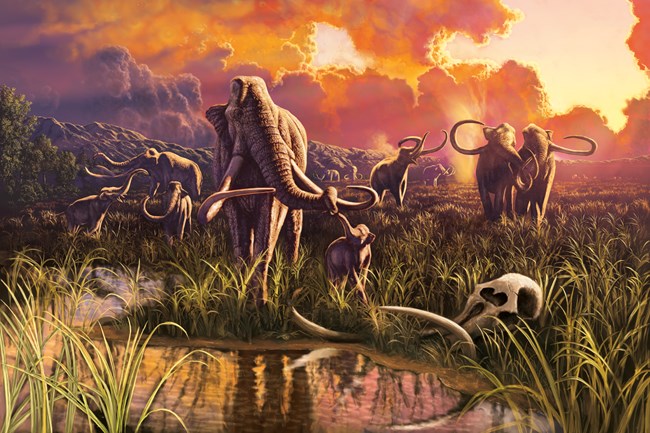
NPS Image Trail OverviewThe Durango Loop Trail offers scenic views of the Las Vegas and Sheep Ranges (to the north), as well as the Spring Mountains (to the west). On this trail, you will pass through Ice Age badlands as you experience the modern Mojave Desert landscape.The descriptions below of each of the four stops can also be found by scanning the QR codes along the trail. Most smartphones are able to scan QR codes by opening the camera app, placing the QR code within frame, and clicking the link that appears. Self-Guided Tour
NPS Photo | Andrew Cattoir Stop 1The story of water at Tule Springs Fossil Beds begins hundreds of millions of years ago. Right now, you are surrounded by mountains that are much older than the Ice Age sediments and fossils of Tule Springs. The Spring Mountains to the west and the Sheep and Las Vegas Ranges to the northeast stand tall above the upper Las Vegas Wash, as they did when this area was filled with wetlands between ~570,000-10,600 years ago. Melted snow and rainfall on these mountains seep through the porous rock to slowly travel down to underground aquifers below your feet, as it has for millennia. Water that is stored underground can flow to the surface by way of faults, which are breaks in the Earth’s crust. During more wet periods, groundwater springs appeared on the landscape as marshes, pools, streams, and wet meadows. During drier interglacial periods, wetlands shrank at Tule Springs.
NPS Image | Julius Csotonyi Stop 2Like the accumulation of dust on household surfaces, tiny pieces of silt and mud were picked up by the wind and came to rest in the Ice Age wetlands of Tule Springs. Little by little, layers formed and recorded changes in the environment through time, in a process called deposition. Although the walls of the Upper Las Vegas Wash were formed slowly over thousands of years, powerful flash floods can carve through the soft sediment very quickly. Flowing water from winter rains and summer monsoons can pick up sediment in the swift current and deposit it elsewhere in the valley in a natural process called erosion. The larger pieces of rock and gravel that line the trail within the wash were carried by swiftly flowing water during flash floods. Many of these rocks came from the surrounding mountains.
Protectors of Tule Springs Stop 3The effects of erosion can cause large blocks of the badlands to come crashing down in sediment slumps or falls. While it is exciting to see erosion in action, it is unpredictable--the safest place to hike the Durango Loop is away from the edge of the wash walls. This section of the wash adjacent to the trail is severely undercut and could fall at any moment! Staying on the trail and away from the edge will help you recreate safely and responsibly while at Tule Springs Fossil Beds National Monument.Durango Short Loop Citizen Science StationHow can you help? Anyone can be a citizen scientist! 
San Bernardino County Museum Stop 4Water also plays an important role in the preservation of fossils. Not every single animal that lived at Tule Springs got to become a fossil; if they were not buried quickly, the remains of animals could have washed away, been scavenged on by other animals, or trampled on and broken apart. Some of the wetland environments of Ice Age Tule Springs were a little better at burying bones than others. For example, spring-fed streams had flowing water that could more quickly and easily move sediment to bury animal remains. Other environments, like marshes, had more still, shallow water where bones were buried much more slowly and sporadically. Today, erosion can help expose fossils at the surface, giving park paleontologists an opportunity to preserve and study them. If you have not seen a fossil at Tule Springs, do not worry --There may be hundreds of fossils still buried underneath your feet! Follow these links to learn more about Paleontology and the prehistoric creatures of Tule Springs Fossil Beds. |
Last updated: February 4, 2025
